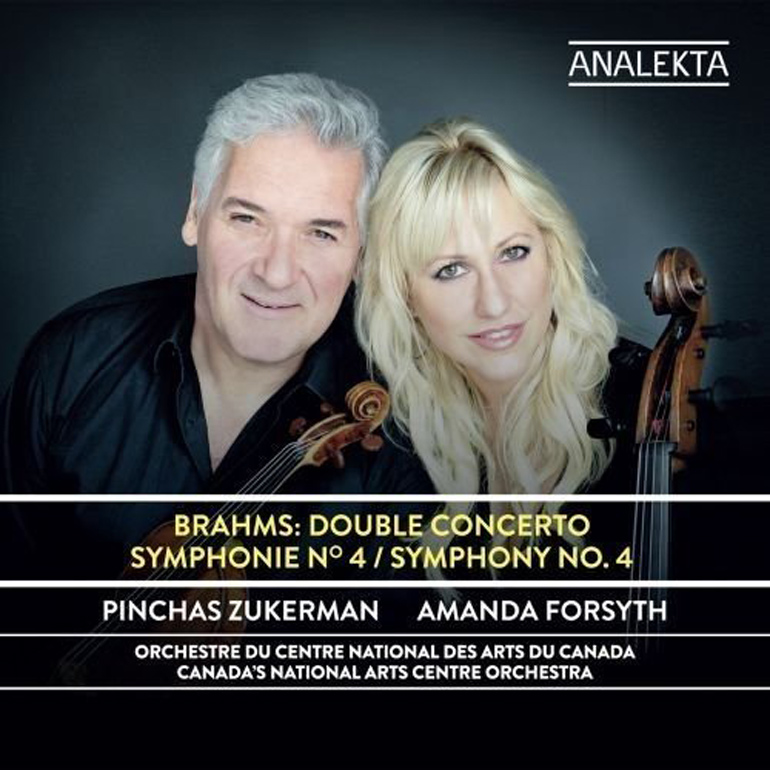
Brahms: Concerto for Violin, Cello and Orchestra in a minor Op. 102. Symphony No. 4 in e minor Op. 98. Pinchas Zukerman, violin. Amanda Forsyth, cello. National Arts Centre Orchestra/Pinchas Zukerman. Analekta AN2 8782. Total Time: 73.28.
After more than 15 years at the helm, Pinchas Zukerman recently stepped down from his post as music director of the National Arts Centre Orchestra (NAC) in Ottawa. Zukerman came to Ottawa as a celebrated solo violinist (and violist) and a part-time conductor of modest reputation. At the time, it was certainly considered a coup for the NAC to contract such a prestigious musician to lead its orchestra, although doubts were expressed about what he might be able to accomplish as a conductor.
On the whole, Zukerman proved to be an efficient – if only occasionally inspiring – conductor. He was given great credit for improving the quality of the strings in the orchestra, but was often criticized for his limited repertoire and his lack of interest in Canadian music.
During his tenure in Ottawa, Zuckerman developed a relationship with cellist Amanda Forsyth and they eventually married. She also became principal cellist of the NAC Orchestra and a frequent collaborator with Zukerman in chamber music performances. Despite this intersection of his professional and personal life, he managed to survive the inevitable charges of conflict of interest.
Zukerman and Forsyth have played the Brahms Double Concerto on many occasions and this live performance from November, 2014 demonstrates their unique rapport. Neither soloist attempts to grab the spotlight or tries to personalize the music in any way. This is simply professional music-making at the highest level. I have always admired Zukerman’s integrity in the standard repertoire and with Forsyth as his partner they play Brahms with impeccable intonation and beautiful, singing tone.
The National Arts Centre Orchestra was created in 1969 as a ‘largish’ chamber orchestra – a chamber symphony, if you will – and under founding conductor Mario Bernardi, it soon became renowned for its wonderful sense of style, especially in the music of Mozart. But before long, it also became clear that, as the resident orchestra of the National Arts Centre, it needed to present a wider repertoire; hence, from time to time, over the years, it was enlarged for performances of Tchaikovsky, Richard Strauss and Mahler. Finally, under Zukerman, the ‘core’ orchestra was expanded to 61 musicians.
I have no idea how many players the NAC Orchestra used for this recording of the Fourth Symphony, but 61 would have been a larger number than the composer had available for the first performance by the Meiningen Court Orchestra in 1886.
We often hear the Brahms symphonies played today by much larger orchestras, and in his lifetime, Brahms himself conducted a performance of the Second Symphony using 113 players.
Can one correctly claim a ‘right’ size for a Brahms orchestra? Probably not, but Zukerman is clearly opting for a complement of players very much in line with what the composer preferred.
Using only about 60 players allows the woodwinds to be heard with no difficulty at all and that pleasing clarity is what we have in this recording. The woodwinds of the NAC Orchestra are superb musicians and contribute no end of pleasure to this reading of the Fourth Symphony. On the whole, however, I did feel that Zukerman tends, in this performance, to sacrifice intensity and drama for the sake of transparency. The timpani, for example, is very much under wraps even though it has much to contribute, especially at the end of the first movement and throughout the 3rd and 4th movements. The result is a beautifully-played Brahms Fourth, which, while achieving an admirable chamber music quality, tends to be somewhat dry-eyed.
Wilhem Furtwängler set the bar very high in expressing a vast range of emotion in this symphony (Berlin Philharmonic, PRISTINE, 1943), and more recently, Riccardo Chailly (Gewanthausorchester, DECCA, 2013) has shown that a more restrained approach need not be lacking in intensity.
CD available at amazaon.ca and iTunes.
#LUDWIGVAN
Want more updates on Toronto-centric classical music news and review before anyone else finds out? Get our exclusive newsletter here and follow us on Facebook for all the latest.
- SCRUTINY | TSO Lets Berlioz Do The Talking In Season Opener - September 21, 2018
- RECORD KEEPING | Even Yannick Nézet-Séguin Can’t Make Us Love Mozart’s La Clemenza di Tito - September 6, 2018
- RECORD KEEPING | Giovanna d’Arco With Anna Netrebko Explains Why The Best Operas Survive - August 30, 2018



